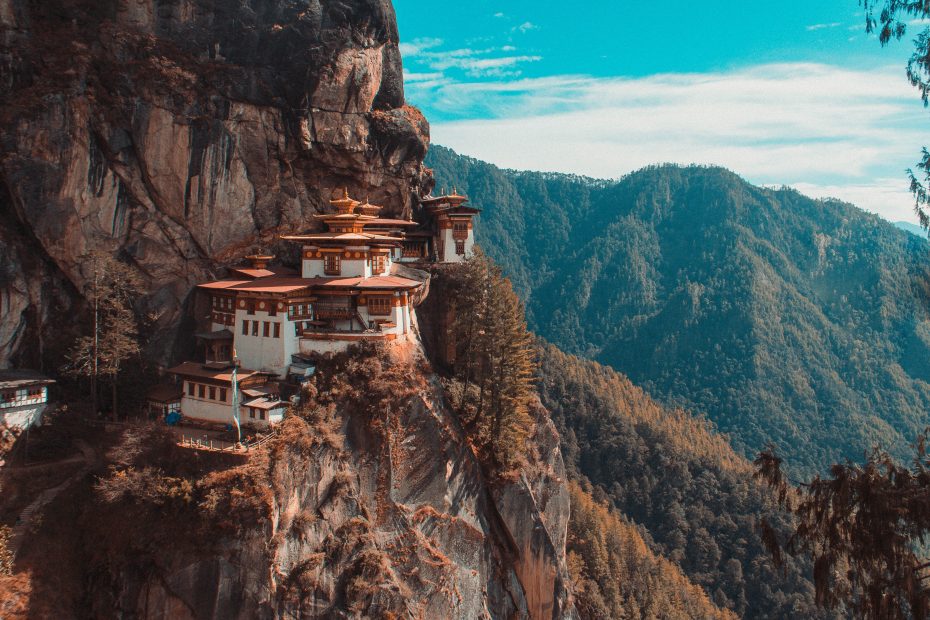Table of Contents
Introduction to Bhutan
Nestled in the eastern Himalayas between India and China lies the small kingdom of Bhutan, aptly known as the Land of the Thunder Dragon. Though one of the world’s smallest countries by area, Bhutan punches above its weight with breathtaking mountain scenery, ancient Buddhist culture, and warm-hearted people. Bhutan only opened its doors to outsiders in the 1970s, helping preserve its long-isolated traditions. Let’s explore the magic of this fascinating Himalayan kingdom!
Culture and Traditions
Buddhism
At the heart of Bhutanese life is Tibetan Buddhism, brought from Tibet in the 8th century. Beautiful dzongs (fortresses) and monasteries dot the valleys, with spinning prayer wheels and the smell of burning butter lamps. Buddhism shapes daily life, from greeting someone with a handshake to receiving a blessing from a monk.
Dzong Architecture
Dzongs are Bhutan’s most recognizable landmarks, with their high walls, inward-slanting windows, and towering UTse (central towers). Dzongs serve as both monasteries and administrative centers. The largest is Punakha Dzong, the former capital’s 17th-century dzong impressively located at the confluence of two rivers.
Traditional Clothing
Bhutanese proudly wear traditional dress in public. For men, this is the gho, a knee-length robe tied around the waist. Women don the ankle-length kira paired with a blouse. These outfits feature colorful stripes and patterns, showcasing Bhutan’s textile arts.
Cuisine
Bhutanese cuisine reflects the country’s cool mountain climate, with warm and comforting foods. Common ingredients include red rice, buckwheat, potatoes, mushrooms, ferns, chili peppers, cheese, and yak meat. Try these flavorful dishes:
- Ema datshi – the national dish of chilies and cheese
- Phaksha paa – pork cooked in stewed vegetables
- Jasha maru – spicy chicken stew
- Momos – stuffed dumplings with meat or cheese
Traditional eating etiquette includes eating with the right hand and passing food to others before serving yourself. Mealtimes offer opportunities to gather with family and friends.
Trekking and Adventure Sports
Bhutan offers outdoor enthusiasts plenty of chances for adventure:
Hiking
With over 70% mountainous terrain, Bhutan is a trekker’s paradise. Hike through blue pine forests to serene monasteries like the iconic Tiger’s Nest, perched on a sheer cliff. Challenge yourself summiting mountain passes above 13,000 ft. Guides and pack animals available for multi-day treks.
River Rafting
Bhutan’s fast-flowing rivers offer thrilling white-water rafting. The Raidak and Sunkosh rivers feature fun rapids for beginners and experts alike. Raft past cliffs and canyons for an adrenaline rush!
Rock Climbing
Bhutan’s rugged cliffs attract avid rock climbers. Climbing sites offer diverse challenges, whether you’re a novice or a veteran looking to summit a 20,000 ft peak. Thimphu has an indoor climbing gym with routes and an outdoor natural rock wall.
Festivals and Events
Colorful Bhutanese festivals showcase Buddhist teachings and local culture:
Tshechu
Tshechus are held annually at dzongs and monasteries. These religious festivals feature masked dancers performing scenes from Buddhist texts set to traditional music. Attend to glimpse sacred cham dances.
Bhutanese New Year
Losar, the Lunar New Year, ushers in springtime with rituals at home and in monasteries. Families hang colorful prayer flags and share special foods like red rice.
Royal Highland Festival
Experience local lifestyles and traditions at this festival showcasing Bhutan’s rich cultural diversity. Expect folk dances, songs, traditional sports, and artisan handicrafts.
Wildlife and Nature
Bhutan balances Buddhist ideals of compassion with environmental conservation. Over 70% of its terrain is protected in national parks teeming with biodiversity:
- Jigme Dorji is home to snow leopards, blue sheep, and over 300 bird species.
- Thrumshingla offers prime hiking and spotting endemic black-necked cranes.
- Sakteng protects exotic flora like rhododendrons and the rare blue poppy.
As the world’s only carbon-negative country, Bhutan is a model of sustainable development. Its constitution mandates maintaining 60% forest cover for future generations to enjoy.
Travel Tips
Here are some tips to make the most of your Bhutan experience:
When to Visit
Spring (March-May) and autumn (September-November) have pleasant weather ideal for trekking and festivals. Summers are monsoon season. Book tours 6 months in advance due to quotas.
Getting Around
A guided tour is mandatory and will provide transport by vehicle or guided hikes. Internal flights connect Paro and Bumthang. Taxis are available in major towns.
Accommodation
Stay in a traditional Bhutanese hotel or farmhouse with basic amenities. Higher end hotels available in cities like Thimphu and Paro. Camping options during treks. Book well in advance.
Conclusion
Few places feel as untouched or offer such a unique cultural immersion as the otherworldly kingdom of Bhutan. Get off the beaten path to magnificent monasteries, untouched wilderness, and colorful traditions in this remote Himalayan wonderland. Come with an open mind to soak up Bhutan’s one-of-a-kind atmosphere. You’ll surely find a trip here filled with delightful surprises that you’ll remember forever!
FAQs
What is Bhutan famous for?
Bhutan is famous for its breathtaking Himalayan scenery, ancient Buddhist culture and monasteries, gross national happiness development philosophy, and rich biodiversity. It’s the world’s only carbon-negative country.
What is the best time to visit Bhutan?
Spring (March to May) and autumn (September to November) are the best times to visit due to their mild weather and colorful festivals like Paro Tsechu.
Do you need a visa for Bhutan?
Yes, all foreign visitors to Bhutan require a visa and must book their trip through an approved tour operator. The mandatory daily package fees help limit Bhutan’s tourism impact.
What can you not do in Bhutan?
Some actions prohibited in Bhutan include smoking in public places, buying/selling tobacco, damaging plants, littering, or making noise near sacred sites. Travelers should dress modestly when visiting religious sites.
What is Bhutan famous food?
Bhutan is known for dishes like ema datshi (chilies and cheese), phaksha paa (pork with vegetables), momos (dumplings), and other warming foods featuring ingredients like chilies, cheese, mushrooms, and noodles.
